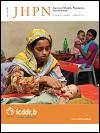Does Dietary Intake by Tehranian Adults Align with the 2005 Dietary Guidelines for Americans? Observations from the Tehran Lipid and Glucose Study
DOI:
https://doi.org/10.3329/jhpn.v29i1.7564Keywords:
Adherence, Adults, Calorie intake, Diet, Guidelines, Nutrition, IranAbstract
The aim of this study was to compare dietary intakes by Tehranian adults with recent dietary guidelines for the Americans. The study made a cross-sectional assessment of the dietary patterns of Tehranian adults using a validated food-frequency questionnaire. It included 2,510 subjects (1,121 men and 1,389 women) aged 19-70 years. They were the participants of the third follow-up survey of the Tehran Lipid and Glucose Study (2005-2008). The dietary patterns were assessed using the latest World Health Organization (WHO)’s nutritional goals and Dietary Guidelines for the Americans Adherence Index (DGAI) 2005. The mean [standard deviation (SD)] DGAI score for this population was 8.31 (1.9). Participants in the highest quartile category of DGAI were more likely to be female, older, non-smoking, and physically active than those in the lowest quartile category (p<0.001). Percentage of participants meeting the DGA recommendations was low, especially for starchy vegetables (2.3%), orange vegetables (16.2%), lean meat (9.2%), grains (12.0%), and legumes (6.4%). Over-consumption of grains was observed in almost half of the participants while approximately 20% of the subjects over-consumed milk and meat groups. Intakes of most nutrients examined were significantly associated with the DGAI 2005 score (p<0.001), except for vitamin E, vitamin B12, and vitamin D. The least adherence with the WHO goals was observed with n-3 PUFAs, sodium, fruit, and vegetable intakes. The results revealed that the dietary patterns of most Tehranian adults did not comply with the 2005 DGA and nutritional goals of WHO/Food and Agriculture Organization.
Key words: Adherence; Adults; Calorie intake; Diet; Guidelines; Nutrition; Iran
DOI: 10.3329/jhpn.v29i1.7564
J HEALTH POPUL NUTR 2011 Feb;29(1):39-52Downloads
916
617

